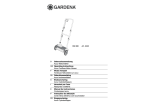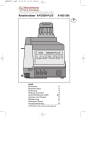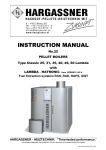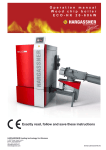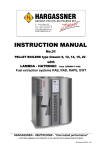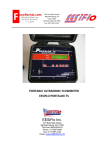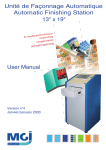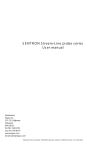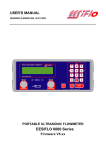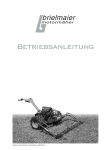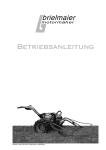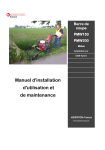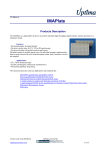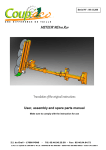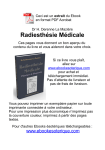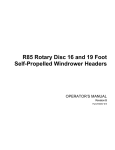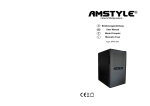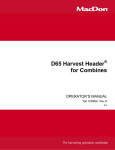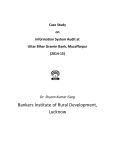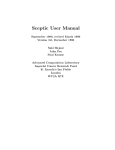Download brielmaier Operating manual Brielmaier motor mower brielmaier
Transcript
brielmaier motor mower Operating manual Brielmaier motor mower (Errors and technical alterations excepted) www.brielmaier.com · [email protected] brielmaier motor mower Table of Contents 1. Safty rules 1.1 1.2 1.3 1.4 1.5 1.6 General information and designated use General safety and accident prevention rules Warning informations and signal words Further safety guidelines before operating the machine Remaining risks Safety on slopes 4 4 5 5 6 7 8 2. Safety lables, workspace and danger zone 9 3. Description of device, Manufacturer's address, type lable and approval marks 10 4. Technical specifications 11 5. Vibration measurement at the handles – Noise measurement 12 12 12 5.1 Vibration measurement at the handles 5.2 Noise values of the Brielmaier motor mower 6. Declaration of conformity 13 7. The key controls 14 14 16 16 17 18 7.1 7.2 7.3 7.4 7.5 Control elements left hand Ignition/ button LED display Right hand settings The LED-Display and menu items details 8. Directions for loading and securing the mower for transport 8.1 8.2 8.3 8.4 8.5 Loading ramp Loading direction Lashing of the mower Lifting eye Cutter bars mounted lenghtwise 9. Operating instructions 9.1Preparation 9.2Refuelling 9.3 Adjustable steering bar 9.4 Starting the engine 9.5 Switch off the engine 10. Moving and mowing 10.1 10.2 10.3 10.4 10.5 Preparation to start Driving operation Behavior in case of sudden danger Moving the machine when the engine is switched off Starting the cutter bar 11. Device replacement 11.1 11.2 11.3 11.4 Preparation for device replacement Removing of the current equipment Connecting the equipment to the machine Stably parking of the mower without cutting equipment 12. Wheel change and wheel mounting 12.1 12.2 12.3 12.4 Studded roller wheels Rubber wheels Set of tires Safty instructions for the wheel change 20 20 20 20 21 21 22 22 22 22 23 23 24 24 24 25 25 26 27 27 27 28 28 29 29 29 29 29 2 brielmaier motor mower Table of Contents 13. Manual and safety guidelines of the company ESM / Cutter bars 13.1 General safety guidelines for all ESM products 13.2 Installation and user instructions for double-knife cutter bars, system Busatis „BIDUX“ 13.3 Installation and user instructions for double-knife: open pivot cutter drive 14. Removing and fitting the knives , additional Brielmaier practical tips 14.1 Removing the upper knife 14.2 Removing the lower knife 14.3 Fitting the knives 15. Lubrication of the knives an the cutter bars 15.1 Lubrication of the knives 15.2 Lubrication of the cutter with cutter bars up to 2,35 m 15.3 Lubrication of the cutter with cutter bars from 2,60 m on 16. Maintenance and repair 16.1 Maintenance after use – Exchange of worn parts and oil 16.2 Regular maintenance – daily / before each use 30 30 32 37 39 39 40 40 41 41 41 41 42 42 42 17. Disposal 43 18. Engine oil and hydraulic oil 44 44 44 45 18.1 Engine oil 18.2 hydraulic oil 18.3 Oil filter 19. Cleaning an maintenance of the air filter, hydraulic oil temperature and engine cooling system 19.1 Air filter 19.2 hydraulic oil temperature and engine cooling system 46 46 46 20. Warning and safty guidelines for starter batteries 47 21. Instructions for starter batteries 48 48 48 48 48 49 49 49 21.1 21.2 21.3 21.4 21.5 21.6 21.7 Connecting the charger Removing and installing the battery in the mower Battery maintenance Motor mower out of use for long period Jump starting Jump starting without direct access to the battery Battery not in use 22. Troubleshooting 50 23. Electronics-troubleshooting and settings 51 51 51 51 23.1 Suspicion of electronic damage 23.2 Main board and error codes 23.3 Parameter setting of the rake tedder 24. Hydraulic plan 52 25. Electric circuit diagram 53 26. Catchword index 54 3 brielmaier motor mower 1. Safety rules 1.1 General information and designated use Congratulation on buying your Brielmaier motor mower! Many years of development and a continuous exchange with our clients enable us to offer you a mower that sets standards in efficiency and safety. But despite of all the safety we have thought about when designing and assembling the machine, in the end it is still the operator who defines, how safe his work really is. Therefor: Please read this manual carefully ! It contains many important hints and tips, to use the Brielmaier motor mower safely, proper and faultlessly and prevent hazard or even accidents at work! The Brielmaier motormower is designed exclusively for the conventional use in agriculture, forestry, cultivation of greens and facilities, municipal use and winter services. Every use beyond that is no designated use. Designated use also means keeping the required operating, service and maintenance conditions. The Brielmaier motormower may only be used, maintained or repaired by persons that have the appropriate skills and are informed about the hazard potentials. We are not responsible for damages or errors that are caused by non-observance of this manual or unauthorized changes of the machine ! Read at least all the safety instructions ! 4 brielmaier motor mower 1. Safety rules 1.2 General safety and accident prevention rules Basic rule: before each operation check the reliability ! 1. Next to the recommendations in this manual always note the general safety and accident prevention regulations ! 2. Juveniles under 16 must not operate the mower ! 3. When using public roads the relevant regulations and road traffic rules must be observed ! 4. Before starting work, familiarize yourself with all the features and operating controls as well as their functions. Ensure that all protective devices are installed properly. During the assignment it is too late ! 5. The operator is responsible for third parties in the working area! Make sure that you secure it against access by people (children!) and animals, especially in the immediate vicinity of the machine. 6. The stay in the danger zone of the machine is prohibited ! 7. Before performing maintenance and cleaning shut down the mower and remove the ignition key ! 8. Never run the engine in confined spaces - hazard of of suffocation through the carbon monoxide emissions ! 9. Wear close-fitting work clothes, since loose clothing increases the risk of accident. Also wear sturdy, closed shoes with sufficient tread. 10. Caution when dealing with fuel – increased fire risk. Never refill near open flames, sparks or hot engine parts. Never smoke when refueling ! 11. Stop engine before refueling and pull out ignition key. Never refill fuel in closed rooms ! Use appropriate funnel ! 12. To avoid fire hazard, always keep the machine clean ! 1.3 Warning informations and signal words Following signal words are used in the manual to make you aware of danger. Please pass on all safety advice also to other users. Please hee all measures marked with the danger sign to prevent injuries or death. Signal words/ danger sign Notice Hazard classification according to international standards NOTICE indicates a potentially hazardous situation, which - if the warnings and notes are not observed - could result in material damage ! The DANGER SIGN warns about danger of injury ! Caution CAUTION indicates a potentially hazardous situation, which - if the warnings and notes are not observed - could result in minor or modrate injuries ! Warning WARNING indicates a potentially hazardous situation, which - if the warnings and notes are not observed - could result in major injuries or death ! Danger DANGER indicates a potentially hazardous situation, which - if the warnings and notes are not observed - almost certain lead to major injuries or death. This classification of highest hazard situations does not occur at the Brielmaier motor mower. 5 brielmaier motor mower 1. Safety rules 1.4 Further safety guidelines before operating the machine The most important safety guidelines given in this handbook cannot cover all eventualities. Common sense and caution are obviously not built – in features of a motor mower – they must be provided by the person using and maintaining it. To reduce the risk of accident as much as possible, please heed the following instructions: • Execute the first commisioning only after you have read the operating instructions and familiarised yourself with the control functions • The first time you use the Brielmaier motor mower, choose a clear and level area of ground • Damp and rainy conditions increase the danger of slipping and skidding, so take extra care when mowing on slopes and steep inclines and only mow on dry ground that gives you a good grip •The Brielmaier Motormäher is designed exclusively for use as a mower or for use with Brielmaier accessories. Any and all misuse can unnecessarily endanger the operator or third parties • Always only use genuine spare parts of the Brielmaier Motormäher GmbH. Only they fulfill the committed technichal demands • Always remove the cutter guard before starting the engine. When you have finished mowing, always turn off the engine before putting the cutter guard back on. Make sure especially that the cutter guard is fitted during long periods of inactivity (in shed, garage, etc.) • Regarding the knives please read the safety guidelines of the producer ESM on the pages 30-38! • The fitted safety equipment such as the burn guard on the exhaust pipe and other safety guards should never be removed. If these fittings become damaged, switch the mower off immediately and arrange a proper repair •The Brielmaier motor mower is designed for the use on slopes. Anyway you must consider a margin for safety, to guarantee the stability of the machine and prevent slipping off. Also look for loose stones! The speed must be adjusted to the ground conditions and it is the responsibility of the operator to choose the right speed to prevent any danger! • All the controls must engage cleanly, run smoothly and be in good working order • Note: If unleaded fuel is stored for a long period, it can lose its ability to ignite and may form deposits. It should therefore be stored for no more than three months maximum Bevore commissioning always check that • the machine has enough engine oil and hydraulic oil • the tank is full • the knives are sharp • the swing arm bearings, pivot bolts and knife guide arms on the mushroom-headed bolt area of the knife blades are lubricated Ear protectors As the noise level of the 4-cycle engine at full throttle and the cutter exceed 90 dB(A), you are advised to wear ear protectors in line with standard safety guidelines. Please note the detailed information on noise measurement values on page 12. 6 brielmaier motor mower 1. Safety rules 1.5 Remaining risks ! Warning Hazard Potential consequences Evasive / avoidance actions to be taken Explosion hazard through ignited petrol severe burns all over the body and in the face DO NOT refuel the mower when the motor ist hot use a suitable funnel to fill up the tank Suffocation hazard through exhaust fumes The emission of carbon NEVER run the enginge in a closed area monoxid from exhaust can lead to smoke poisoning with following symptoms: headache, respiratory distress, nausea, unconsciousness, death Cutting damage hazard at the cutter bar serious cut injuries or cutting of parts of the body when the cutter bar is running! When the engine is running NEVER remove the cutter guard NEVER touch the cutter bar NEVER walk in front of the cutter MAKE SURE that nobody is in front of the mower Risk of injuries through flying parts Overturn of the mower on very steep slopes as well as slipping off While using the mulcher or flail mower parts can be hurled away! MAKE SURE, that there are no persons in the danger zone Bruise, contusion, crash at the slope, fractures, death DO NOT drive at the hillside when it is raining or the underground is wet IN CASE OF EMERGENCY switch off the engine immediatly ALLWAYS use suitable shoes and appropriate clothes ALLWAYS consider the soil condition and the sloping EXTREME CAUTION when turning ADVICE observe the instructions at the following pages! NOTICE Hazard Potential consequences Evasive / avoidance actions to be taken The machine is not suitable for towing Drive motors can be broken, because the oil does not then pass through the cooler DONT tow the maschine by another vehicle over longer distances 7 brielmaier motor mower 1. Safety rules 1.6 Safety at a slope Driving at a slope takes allways more concentration and attantion than driving on level ground! Danger of Bruises, contusion, fractures or even death when the mower overturns or crash at the slope, if the following warnings and notes are not observed for driving along the hillside: 1.The recommended values are valid on intact turf and good weather conditions! ! Warning 2.Topographic conditions can change and cause a hazard in operation! 3.If the slope changes, if the trip leads over a dirt track, stones are in the road or the weather changes, there may be danger of falling on the slopes! 4.The ultimate responsibility always lies with the user! The driver should always „read“ the terrain in front and adjust the speed and direction of drive according to the circumstances! 5.Special care must always be taken when turning on slopes! The guidelines listed below were obtained in a number of practice tests and show, which inclination is to be managed safely with which kind of tires under normal conditions. Due to its special construction the Brielmaier motor mower is notably capable to mow slopes. Due to the consequent hydraulic design the Brielmaier motor mower comes with a very low center of gravity, which reduces the use of force especially on a slope noticeably. Comparative physical effort: brielmaier conventional motor mower Center of gravity Pivot motor mower Physical leverage Force on driver in order to hold mower Values for slope capability in % slope, depending on the tires chosen Simple standard 5.00 x 12 Terra 23x10,50 Twin 5.00 x 12 35 % 35 % 40 % 5.00 x 12 Studded roller Studded roller Studded roller + studded roller wheel high wheel, 4 rows wheel low wheel 50 % 65 % 65 % 70 % 8 brielmaier 2. Safety labels, workspace and danger zone motor mower True safety means knowing and understanding all the safety labels. These indicate the nature and location of the danger and above all the safety measures that need to be taken. Please be vigilant and aware of possible danger(s) at all times. This machine carries warning symbols (safety labels). The labels and corresponding explanations are set out below in their full illustrations: Danger zone! The workplace of the operator is exclusively locatet behind the steering bar in the green labeled area ! 0,5 - 1m 3 - 5m The danger zone covers the red labeled area. An individual consideration is the task of the operator! Workplace Prevent the entry of any person into that area and in case of doubt turn the mower off, if someone should nevertheless move into this zone ! Ear-protection advice 0,5 - 1m Read and follow the operating instructions and safety guidelines before using the machine ! Turn the engine off and remove the key before attempting any maintenance or repairs ! Danger from moving parts when engine is running – keep a safe distance ! Read and follow the operating instructions and safety guidelines before using the machine ! 9 3. Description of device, Manufacturer's address, Type label and approval marks brielmaier motor mower Description of device The Brielmaier motor mower is a single-axis broad-gauge mower for use in the most extreme alpine and municipal areas. It is characterised especially by its consistent use of hydraulic technology. The Brielmaier motor mower is powered by a 4-cycle petrol engine. This drives three gear pumps, which supply the oil engines for the wheel and cutting bar drives via finely tuned valve technology. This modern valve technology removes the need for any gears and mechanical coupling! Each wheel is driven by its own hub motor. Cutter bars from 4' to 11'6" of our own production can be connected to the hydraulic couplings of the equipment drive as well as mowers, tedders, rakes, snow blowers and many other attachments from other manufacturers. We are using sturdy double-knife portal cutter bars, system „Bidux“. The cutter bars up to 7'9" are equipped with a swing arm drive, the bars from 8'6" with a lateral eccentric drive. Our patented self-cleaning studded roller-wheels are the first choice for the use on hills and slopes, on request, we also provide tires in different dimensions. The handling of the mower during operation is done by push-buttons, levers and a twist grip on the handlebars, which the operator normally does not need to release. Thus ergonomics and safety are implemented in the highest degree. Gas and oil • All our engines run on standard unleaded petrol • As engine oil ex-works we use Panolin Motoröl Universal FE 10W40 semi-synthetic • As hydraulic oil we use the biodegradable Panolin HLP46 synthetic (do not blend this!) • CAUTION: Never blend these oils with other types or qualities! Otherwise there is the danger of foaming ! Manufacturer's address Brielmaier Motormäher GmbH Alt Eggenweiler 11 88048 Friedrichshafen / Germany Phone + 49 (0) 75 46 - 917 615 Fax + 49 (0) 75 46 - 917 616 Mail: [email protected] Web: www.brielmaier.com Type label and approval marks The type label is situated on the right hand side underneath the steering bar on the main chassis and allows the clear identification of your mower. Please tell us these data when ordering spare parts or in case of questions or complaints. CE-sign (German / European safety sign) The CE-sign is to be found on the type label. Alt-Eggenweiler 11 88048 Friedrichshafen Type Fabr.Nr. Masse Baujahr GS-sign BLT Wieselburg The mower has been tested by an independant authority and fulfills the conditions of the Product Liability and Product Safety Act (Europe) Seal of the Austrian Authority for Agricultural Technology in Wieselburg 10 brielmaier motor mower 4. Technical specifications Brielmaier Motor Mower 20 kW/27 PS Type 108.00001.45 Engine type Kohler Command CH 740 Number of cylinders 2 Power at rpm 20 kW (27 hp) 3,600 min-1 Cubic capacity 45 in3 Maximum torque 56.4 Nm / 2.200 min-1 Tank capacity/ fuel 2.4 Gallons / unleaded Motor oil 10W40 (mineral oil) Speed 0 - 4.5 mph variable Tank capacity hydraulic oil Required quality hydraulic oil 2.1 Gallons biodegradeable Panolin HLP46 synthetisch (do not blend whith other oils, danger of foaming !) Max. hydraulic pressure Wheel drive Equipment drive 200 bar 220 bar (option: variably adjustable) Tire pressure 5.00 x 12" Terra tires 0,8 bar 0,5 bar Weight of base maschine Minimum: with standard tires Maximum: with steel ext. wheels 490 lbs 586 lbs Dimensions of base machine Width min.: with standard tires Width max.: with roller wheels low Lenght (without cutter bar)/ height 3'12" 6'9" 6'3" / 3'7" Cutter bar weights 4' 190 lbs 5'3" 210 lbs 6'7" 230 lbs 7'9" 250 lbs 8'6" 330 lbs 9'10" 345 lbs 11'6" 355 lbs Tire weights for the complete pair Standard 5.00 x 12 Terra 23x10,50 Zwilling 5.00 x 12 59 lbs 71 lbs 130 lbs + studded Studded roller- Studded roller- Studded rollerroller-wheels wheels high wheel, 4-row wheels low 154 lbs 73 lbs 77 lbs 88 lbs 11 brielmaier 5. Vibration measurement at the handles Noise measurement motor mower 5.1 Vibration measurement at the handles By standard DIN EN 12733 we are obligated to measure the vibrations at the handles and mention them in this manual. The DLG text center in 64823 Groß-Umstadt, Germany has conducted the necessary tests for the mower 20kW / 27 hp to the audit number 2007-566 on 10-02-2007. Results if the test report for the mower 20 kW / 27 hp I. Description of the mower 1. Producer and applicant: Brielmaier Motormäher GmbH 2. Type: 108.00001.45 2.1 Nominal power: 27 hp, Kohler Command Pro 27 2.2 Nominal rotation speed: 3.600 -1 3. Serial number: 4007304 4. Knives / Cutter bar with upper and lower knives: 37 blades each, width 8'6" 5. Coating on the handles: Rubber grips 6. Tire pressure: 0,7 bar II. Measurement results – The measurement was performed according to DIN EN 12733:2001 1. Instruments used: 1.1 Acceleration detector: PCB, Type M354C02 SN 1547, M354C02 SN 1762 with integrated charge amplifier, weight: 0.011 lbs 1.2 Frequency weighting filter: DLG self-constructed, filter characteristics comply with ISO 8041 1.3 Tachometer Laser Tacho Type: Mayer + Wonisch, serial number 619596 2. Measurement conditions: Flooring according to Annex C.4.1.2.4 (rubber mats), test section 26 ft., measurement time 16 s III. Results table Travel speed: Cutter stroke rate: 2 ft./s / 2. gear 450 min-1 Vibration measurement of oscillating tools, weighted acceleration in ft./s2 (values should be less than 16.5) Left handle 1 12.8 2 11.2 Right handle 3 12.1 4 10.8 5 12.8 Average 11.8 1 10.8 2 10.8 3 10.8 4 10.8 5 11.2 Average 10.8 5.2 Noise values of the Brielmaier motor mower measured at the operators' ear by test committee on 06-25-2009 Brielmaier Type 1080000145 (27 hp) mit aluminum cutter bar 11'6" (and other aluminum types / widths) Engine speed Noise value (equivalent continuous sound pressure level LAeg) Speed level 1 2.200 min -1 81,5 dB(A), no ear protector required * Speed level 2 2.200 min -1 82,5 dB(A), no ear protector required * Speed level 3 2.550 min -1 84,8 dB(A), no ear protector required * Nominal speed 2.900 min -1 86,5 dB(A), ear protector may be necessary Full throttle, use of mulcher > 90 dB(A), ear protector is required Starting from an exposure of 85 dB (A) ear protectors for employees must be provided free of charge, from 90 dB (A) the use of them is mandatory binding. We recommend that you always wear hearing protection, unless you can rule out over the entire operation, to come above the critical values. 12 brielmaier motor mower 6. Declaration of conformity EU Declaration of Conformity In accordance with EU Guideline 98 / 37 EG and EMV-Guideline 2005 / 108 EWG The manfacturer Brielmaier Motormäher GmbH Alt Eggenweiler 11 88048 Friedrichshafen represented by Martin Brielmaier, CEO, address as above, authorized to compilate the technical documents and to issue this declaration of confirmity, declares as his sole responsibility that the products Brielmaier Motor Mower Type 108.00001.45 (20 kW / 27 hp) built from may, the 1st 2008 on to which this declaration relates conform to the relevant standard safety and health regulations of EU Guideline 2006/42/EG as well as to the standards EN ISO 12100-1/-2, EN 294, EN 349, EN 982, EN 60204-1, EN14121-1 and EN 1553. Correct implementation of the safety and health requirements cited in the EU Guidelines has been ensured by the consultation of the following norms and technical specifications: DIN EN 4254-1 and DIN EN 12733. Friedrichshafen, September, the 1st 2009 Business management, Martin Brielmaier 13 brielmaier motor mower 7. The key controls Cockpit / Display 24 11 12 13 14 7 Left hand 8 15 9 16 17 10 5 2 3 4 21 22 23 18 19 20 Right hand 25 28 27 29 1 26 Double function! For all buttons (2 - 4 and 27 - 29) applies: pressing shortly (less than 0,3 s) causes an other function than pressing longer (more than 0,3 s) ! All controls are ergonomically positioned conveniently close to your grip, so that using the mower is physically effortless and effortlessly easy. 7.1 Controls left hand 1 Handle for clutch and brake functions for gentle starting and stopping, as well as smooth adjustment of speed in both travel directions – reverse / forward – irrespectively of the engine revolutions and pre-selected speed level. When this lever is operated, the wheels brake simultaneously, the mower is force controlled in all gear positions and cannot roll away in any circumstances (100% secure). When the machine is stopped, the wheels brake to a standstill first (lever position B). When the clutch handle is pulled further to position C, the cutter disengages. C: Cutter off B: Stop wheels When moving off, releasing the clutch lever switches the cutter on first and the mower then moves off. A: Continous adjustment range 2 Button changing direction of travel forward/reverse If this button is pressed, the mower will brake slowly, change direction of travel and accelerate to the previous speed. On pressing shortly, the change of direction is permanent. On pressing longer (> 0.3 s) the change of direction is as long as the button is held. The direction of travel selected is displayed as an arrow symbol on the left-hand side of the central display (24): Driving forward Driving backward 14 brielmaier motor mower 7. The key controls Left hand 5 2 3 4 1 3 Button increasing speed level and continuously regulating speed A single, short press of this button (< 0.3 s) sets the speed one level higher (level 1 to 3). If the button is held down continuously, the speed will increase continuously (micro-adjustment of the speed), but only up to the amount that it has been reduced previously, as described in point 4. Notice: On the first selection the speed is adjusted to maximum = 100% within each speed level and can not be raised from this position! The following section 4 describes how the driving speed can be reduced with button 4. Then, the speed can be increased again with button 3, reaching a maximum of up to 100% again. 4 Button reducing speed level and continuously regulating speed A single, short press of this button 4 (< 0.3 s) sets the speed one level lower (level 1 to 3). If the button is held down continuously, the speed will decrease continuously (micro-adjustment of the speed). All values which have been set this way are stored until the mower is shut off. Please also read the information about the memory-function on page 19. Reducing the speed is shown on the display (24) this way: maximum speed reduced speed The speed can also be regulated by turning the throttle (25). Please see also the information on pages 16 and 17 ! 5 Emergency stop switch Safety features ! Safesty features must never be removed or disabled by changes ! To stop the Brielmaier Motor Mower in emergency immediately and to avoid danger the Brielmaier motor mower is equipped with a mechanical emergency stop switch (button 5). To run the machine the emergency stop switch must be held. The warning LED (20) goes out then. As soon as neither handle is held, the machine disengages whithin one second while the engine continues to run. The warning LED „Emergency stop switch active“ (20) starts to glow to indicate this. 15 brielmaier motor mower 7. The key controls Cockpit / Display 7.2 Ignition/ Button 24 11 12 13 14 7 8 7 Ignition key 9 15 16 17 10 21 22 23 18 19 20 9 Button „Light on / off“ (optional) 8 „Start“ button and „Shut down“ 10 Button „Cutter on / off“ 7.3 LED display: 11 12 13 14 15 16 17 18 19 20 Engine revolution Trim Oil pressure of the equipment drive (optional) Amount of oil of the equipment drive (optional) Speed (not yet activated) Hydraulic oil temperature Running hours Service interval (not yet activated) Ignition on Emergency stop switch active Glows, if both handlebars and the emergency stop switch are released. Detailed description on page 15 ! 21 Hydraulic oil temperature too high Glows constantly at 90° C and above, flashes at 105° C and above. Stop working and wait until the hydraulic oil cools down, check the fuse of the fan ! See also the information on pages 44 und 46! 22 Oil pressure too low In this case the machine should shut down itself and the LED indicates a probable loss of oil. If the engine does not shut down itself, immediately stop, shut down the machine and check the oil level! 23 Not yet in use 24 LED central display a) b) c) d) e) a) Direction of travel forward/ reverse Detailed description on page 14 ! b) Selected speed level – to select a speed level Detailed description on page 15! c) Micro-adjustment of the choosen speed level Detailed description on page 15 ! d) Equipment drive operating, pressing button (10) shortly = turning on directly e) Equipment drive active with delay Continuously pressing button (10), until this symbol appears = increase of current over about 6 seconds. Combined with a proportional valve (pressure or amount of oil), this offers smooth, delayed turning on of the device. See also the information on page 26! 16 brielmaier motor mower 7. The key control 7.4 Right hand settings 29 25 Central position: Forward motion Left wheel stopped Left wheel reverses 28 27 26 Right wheel stopped Right wheel reverses 25 Throttle 26 Turnable steering handle The central position of the handle sets forward motion. When the handle is turned left/right, the mower turns left right accordingly and the relevant wheel simultaneously brakes. Reverse is operated in exactly the same way (no need to rethink). When the handle is turned as far as it will go (see diagram), the braked wheel reverses, enabling the machine to turn on the spot. This function is only available on speed levels 1 und 2 and is less effective at speed level 2 27 Menu scroll button This button allows you to select and scroll through the menus from 11 to 17. When pressed longer than 0.3 seconds and then released, you reach the „settings“ menu. With each short press (< about 0.3 s) you can browse the menu items. With another long press you leave the settings menu after releasing the button and switch back to the standard display. 28 (–) button This button reduces the values entered in menues 12, 13, 14 29 (+) button This button increases the values entered in menues 12, 13, 14 12 13 14 17 brielmaier motor mower 7. The key control Cockpit / Display Rechte Hand 11 12 13 14 15 16 17 28 27 29 7.5 LED central display (24) and menue items 11 to 17 in detail 13 Oil pressure of the equipment drive When button 27 is longer pressed (> 0.3 s) and released, you reach the settings menu. If done for the first time, the display changes to the menu item oil pressure of the equipment drive. The LED 13 is showing that. The display shows the value set for the proportional pressure relief valve (standard = 100%) standard value reduced value (example) • This value can be adjusted by pressing buttons 28 (–) and 29 (+) as appropriate. • If buttons 28 and 29 are pressed simultaneously, the value is reset to 100%. • The proportional pressure relief valve is an optional feature. If not installed, you can change the displayed value, but without any effect. The machine is prepared for an upgrade of the valve. A short press of buton 27 switches to the next menu item 14 Equipment drive speed Mode of setting values and display are exactly the same as for the previous menu item. 15 Speed (in kph) is not yet active and is currently skipped.. 16 Haydraulic oil temperature 18 brielmaier motor mower 7. The key control Cockpit / Display 11 12 13 14 15 Right hand 16 17 28 27 29 17 Number of running hours (h) and minutes (m) alternately: left hand 5 2 3 4 11 Engine speed through the next short press of button 27 1 12 Trim status With the trim you can set an individual bending radius to minimize corrections at the steering handle. The trim is adjusted in 100 finely graduated steps to the left or right. When buttons 27 and 28 are held down, the trim is adjusted by about 10 steps per second. When buttons 28 and 29 are pressed simultaneously the value is reset to zero/centre. If the trim is set to right, by pressing both the „centre“ (27) and „left“ (28) buttons it is possible to mirror the trim value on the left and vice versa. start value trim to the right Leaving the settings menu: Every other short press of button 27 browses the menu in the mentioned order. To leave the settings menu press button 27 longer than 0.3 seconds and release, thereupon the standard display appears. When entering the settings menu again with a longer press on button 27 the same menu item will be displayed, which has been set while leaving the menu. Fast access to the trim: By longer pressing (> 0.3 s) of button 28 or 29 the mower will start immediately, to regulate the trim into the respective direction. Afterwards you can browse or leave the menu with button 27 as described above. Memory function for ALL settings: When the mower is turned off, for example to have a little break, ALL values of the settings menu items are stored (i. e. the micro-adjustment of the speed in all three speed levels, the trim, the oil pressure and amount of oil of the equipment drive). After restarting the mower you can reactivate all these values by pressing the buttons 2 and 4 simultanously for more than 0.3 seconds and releasing them. The LED for the menu item „driving speed“ (15) shortly flashes to indicate, that the values have been read out of the memory. 19 brielmaier 8. Directions for loading and securing the mower for transport motor mower Ensure that the towing capacity of towing vehicle and maximum laden weight of the trailer are adequate ! While driving to the place of action always take care of the relvant safety guidelines and traffic regulations! 8.1 Loading ramps ! Warning Hazard the mower may slip off Potential consequences Injuries when the machine falls on the user Evasive/ avoidance actions to be taken Appropriate loading ramps with the requiered loadbearing capacity! Secure the loading ramps firmly to prevent them from slipping backwards ! 8.2 Loading direction Depending on the width of cutter bar and trailer you can either load the mower lenghtwise or crosswise Mower loaded crosswise Mower loaded lenghtwise 8.3 Lashing of the mower Allways make sure the mower is firmly and secure lashed! Look at the examples: ! Warning Hazard Potential consequences Evasive / avoidance actions to be taken Mower can fall from the trailer Property damage and bodily injury of the passangers in the vehicle behind NEVER start without making sure that ALL belts are tighten fast! 20 brielmaier motor mower 8. Directions for loading and securing the mower for transport 8.4 Lifting eye The Brielmaier motor mower ist equipped with two lifting eyes. One lifting eye ist is located at the fixation peg, the other is attached to the frame close to the attachement of the steering bar. The lifting eyes can be used to lash the mower to both sides or to load the mower with a crane Lifting eye on the fixation peg Lifting eye on the frame 8.5 Cutter bars mounted lenghtwise Tipp: The wide cutter bars up to 11'6" can be mounted lenghtwise for transport, as pictured to the right. You need an additional release coupling, which can be ordered and fixed optionally 21 brielmaier motor mower 9. Bringing into service 9.1 Preparation: Before commissioning always check that • the machine has enough engine oil and hydraulic oil • the tank is full • the knives are sharp • the swing arm bearings, pivot bolts and knife guide arms on the mushroom-headed bolt area of the knife blades are lubricated • the main switch is inserted and set to „ON“ (see next page) Fuel gauge 9.2 Filling up fuel The petrol filter tube is on the right-hand side behind the engine as shown above. ! CAution Hazard Explosion hazard through inflamed petrol ! Potential consequences Burns on the body or to the limbs Evasive/ avoidance actions to be taken DO NOT refuel the mower when the motor is hot Use a suitable funnel to fill up the tank Petrol filler tube Also follow the safety instructions on pages 5 to 8 ! 9.3 Adjustable steering bar The steering bar of the Brielmaier motor mower can be adjusted vertically and horizontally. For Hight adjustment • Hold the handle of the bar firmly with your left hand • With your right hand, loosen the handle to the desired adjustment by approx. two turns • Position the handle in the desired position by shifting it up or down or left or right with your left hand • As you do this, ensure that the teeth engage with the adjustment mechanism. On no account must the teeth sit on top of each other • Retighten the handle steering bar adjustment Lifting eye . For the lateral adjustment use the same procedure but instead of loosening the lever, loose the lifting eye with a screwdriver or something similiar and after readjusting the steering bar retighten it again. ! Caution Hazard Potential consequences Evasive / avoidance actions to be taken Mower can overturn over the transverse axis when no cutter or other equipment is attached to it Property damage on the mower or bruises through the contact with the mower NEVER adjust the steering bar when no device is attached or the mower does not stand stabil! 22 brielmaier motor mower 9. Operation instructions 9.4 Turn on the engine Right handle 25 1. Turn the throttle (25) approx. 1 cm down 2. Set the choke to the midway position at least and to maximum for a cold start (generally only necessary in extremely cold conditions) only for a short time and set it back to the midway position once the engine starts Choke „Off /Continuous operation“ „Maximum“ and „Midway“ From the midway position, set to „continuous operation“ after a maximum of one minute. If the engine is running smoothly, this setting can be maintained. If the engine stops while the choke is in the continuous operation position, revert briefly to the middle position 5 Left handle 3. Dead man´s system (5) note: do NOT grip the handles (5) while you are starting the engine 4. Check main switch (also see pictures down right), if necessary insert into the provided opening and turn it 90° clockwise until it engages 5. Ignition key (7) turn as far as it will go in the opening provided 6. Start button (8) press and hold it down until the starter motor responds, then release when the motor is running • Hint: First the electronic of the mower is running a self-test. During this procedure the LEDs of the display are flashing irregularly to indicate this 7. If the engine does not fire: • Check the fuel, refill, if necessary and try again with other position of the choke Ignition key 7 Start button 8 • Check battery and fuses • Check main switch The main switch serves the durable disconnection of the electrical circuit to close down the mower (e. g. during wintertime) or as theft protection. The mower only starts when the main switch is installed and turned. Fuel gauge Main switch 9.5 Turn off the engine 1. Start button (8) press shortly when the mower is running. All functions, equipment and light turn off. The display expires after approx. 5 seconds. 23 brielmaier motor mower 10. Driving off and mowing Left hand Right hand 5 2 3 4 C: Cutter off B: Stop wheels A: Continuous adjustment range 25 28 27 29 26 1 The best way to familiarise yourself with the basic functions of your mower is to choose an open, flat surface on the first few occasions that you use it. 10.1 Preparation to drive off • Clutch-/ brake handle (1) pull the handle as fas as it will go and hold, simultaneously hold the emergency stop switch (5) • Using button 3 set speed level to „1“ . When moving off, do not set a speed higher than „1” as the mower will be too fast (see instructions page 15) • Steering handle (26) leave it in middle position, so that the mower is set to move forward in a straight line. If you turn the handle to the left or right, the mower will move to the left or right accordingly and the relevant wheel will brake. The reverse process is exactly the same (avoid a too powerful steering action) • Make sure no-one is in front of the maschine! • Now release the clutch/brake lever (1) slowly back to its starting position. This lever adjusts the speed continuously between standstill and maximum and is used for gentle starting and stopping (as you pull the lever, the speed is reduced and the wheels brake simultaneously) Drive off! The machine is now running! 10.2 Drive • To change the speed level, press button 3 and 4 on the left-hand steering handle, as described on page 15 • To steer the machine, operate the turnable steering handle (26) as ydescribed on page 17 • To go into reverse, press button (2) briefly (< 0.3 s) to change the direction of travel permanently and hold it down for longer to shunt. • Do not operate the machine in reverse above speed level 1! • The best way to control your speed is by setting the appropriate speed level 1 to 3. Use the micro-adjustment feature (see description on page 12) only when needed, as operating with reduced micro-adjustment increases the heat (the micro-adjustment mechanism produces a programmed loss of power that is converted into heat) Hint: If slower speed is temporarily needed or wanted you can regulate this with the clutch/brake lever (1) very easy, uncomlicated and more flexible than with the micro-adjustment feature. The „clutch“ of the Brielmaier motor mower is NOT a mechanical clutch but a wear-resistant electronically controled hydraulic. With the clutch/brake lever (1) you can regulate the speed within each speed level infinitely variable from zero to the maximum of the selected level, even switching the levels while holding the lever is possible. • When working on steep ground, you can use the trim to pre-programme a particular countermeasure. To adjust the trim see page 19. ➔ 24 brielmaier motor mower 10. Moving off and mowing 10.3 Behaviour in case of sudden danger! Four possibilities to stop the maschine instantly: 1.Pull the handle for clutch and brake functions (1) up as far as it will go and hold ! Thus the wheels will brake, the cutter is shut down, the machine stops instantly. 2. Let go of the emergency stop switch (5)! Thus the wheels will brake within one second and the cutter is shut down. 3. Turn off the engine, push button (8) shortly ! The machine stops instantly. 4. Remove the ignition key (7)! The machine stops instantly. Also read the description of the safety features on page 15! 10.4 Moving the machine when the engine is off To move the mower when the engine is off consider the following: • At the hydraulic block on the top right corner you find a rotary switch that must be turned 90° to put the machine into neutral. • Notice Always turn the rotary switch complete 90°, i.e. either to „drive“ or to „neutral“! Intermediate positions can lead to los of pressure and overheating oil! Direction of drive Position „drive“ Rotary switch Position „neutral“ • Unlock the left and right wheel brake cylinders so that the machine can be moved by hand with the engine switched off. To unlock the left and right wheel brake cylinders: Remove the plastic cap on the wheel brake cylinder, screw the hexagon screw found in the toolbox into the piston rod of the wheel brake cylinder and pull back the piston rod as far as it will go by turning the hexagon nut. 25 brielmaier motor mower 10. Moving off and mowing 10.5 Einschalten des Mähwerks Right hand 25 Throttle Button „Cutter on / off“ 10 • The cutter bar is switched to „on“ or „off“ using button 10. The cutter can be switched on or off either when the mower is moving forward or when it is at a standstill. • If a proportional valve (pressure or amount of oil) is installed, continuously pressing button 10 (>1s) and then releasing it, will increase the current and thus the power of the attached equipment, for example a flail mower, over about 6 seconds. • Proportional valves offer you many individual opportunities on attached equipment. See also page 18. • The throttle (25) controls the speed of the petrol engine. Always try to operate at the lowest speed necessary, as this will reduce wear and tear on the equipment and pollution of the environment. You will be amazed, how much mowing performance you get out of very low revs per minute ! Hint: All mentioned functions and settings of the mower can be switched and toggled in order or combination as you please. Thanks to the electronic control and the hydraulic layout, the machine can thereby never be mechanically damaged (100% crash-proof ! The macine has got no mechanical idle state, thus the mower will never roll away by mistake ! Table proportional pressure relief valve – proportion % versus bar % bar % bar 220 100 250 99 190 99 190 89 180 88 180 100 78 170 75 170 68 160 65 160 58 150 55 150 48 140 45 140 38 130 35 130 28 120 25 120 18 110 15 110 8 100 5 100 0 90 0 95 Litre capacity x pressure / 550 = kW; 30 l x 220 bar / 550 = 12 kW; 250 bar = 13,6 kW 26 brielmaier motor mower 11. Device replacement ! Caution Hazard Potential consequences Evasive / avoidance actions to be taken Risk of burns at the hot exhaust pipe! Skin burns DO NOT touch the hot exhaust pipe 11.1 Preparation for device replacement • Park the mower stably at a flat piece of ground and switch off the ignition • Get the second piece of equipment ready nearby Support foot Locking lever Spring cotter pin Locking screw 11.2 Remove the current equipment from the machine • Loosen the locking screw on the support foot and push the support foot down until you can fix it in the upper hole with the locking screw. Tighten firmly • Remove first the smaller (forerun), then the larger (reflux) hydraulic pipe from the connector • Lay the pipes down in front of you • Lift and secure the steering bar in the upper position • Sicherungsstecker am Verschlußhebel entfernen • Open the locking lever on mower, taking care to hold the mower firmly with the other hand to prevent it from tipping over (see image to the right) • Tip the mower forward until the cutter is resting on the ground on the support foot • Set the steering bar back in its normal working position 27 brielmaier motor mower 11. Device replacement 11.3 Fit the new equiment to the machine • Close the locking lever • Carefully advance towards to the equipment to be attached. Adjust your speed as necessary using the micro-adjustment or the clutch/brake lever • Move forward until the upper part of the snap-lock on the main machine can be slipped into/onto the quick release coupling on the attachment • Push the handlebar of the mower down until the lock engages • Re-secure the locking lever with the spring cotter pin and raise the support foot to the upper position, screw in tightly • attach the hydraulic pipes, first the larger (reflux), then the smaller one (forerun) The Brielmaier mower is now ready to operate with the newly-fitted equipment. ! caution Hazard Potential consequences Evasive / avoidance actions to be taken Release of the equipment Property- and bodily-injuries through uncontrolled rolling equipment ALWAYS ONLY drive with correctly fixed equipment – ALWAYS check tightness! 11.4 Parking the mower stably without cutting equipment Tip: if you lower and fix the steering bar in the lower position, you can also park the mower stably without the cutting equipment. (See image to the right) 28 brielmaier motor mower 12. Change of wheels The Brielmaier motor mower can be equipped with different wheels and tires, which require different material to fasten them, as shown below. Notice When changing from one type of wheel to another, please especially mind the right dimension of the screws! 12.1 Studded roller wheels 12.2 Rubber wheels Studded roller wheels, 3-row, 4-row, 5-row 5 screws 12 x 30 mm Simple standard Terra 5 screws 12 x 25 mm 5 screws 12 x 25 mm 12.3 Set of tires Simple standard + Studded roller wheel Big distance adaptor 5 screws 12 x 25 mm Twin Closure disc 1 screw 12 x 30 mm Distance adaptor 5 screws 12 x 25 mm Closure disc 1 screw 12 x 30 mm 12.4 Safety information for changing the wheel: • Mounting tires and wheels requires sufficient knowledge and proper tools ! • Always mind the running direction of the tires ! • Approximately 5 - 10 working hours after changing the whels you should check and fasten the screws again ! • Always pay attention, that hubs and flanges are clean and free of dirt or little stones ! Otherwise whels could cant and run irregularly ! • Regularly check the tire pressure ! Tire pressure must always be the same left and right ! • Never mount different wheels right and left – always the same wheel on both sides ! ! caution Hazard Potential consequences Evasive / avoidance actions to be taken Loss of a wheel during driving Contusions, bruises, property damage at the machine ALWAYS make sure that all screws are fastened tight and after 5 - 10 working hours check and fasten the screws again! 29 13. M anual of the company ESM 13.1 G eneral safet y prevention rules for all ESM P roducts The cutter bars of Brielmaier motor mower are equiped with high-performance double-knife cutters from ESM. On this page and the following until page 36 you will find safety instructions of ESM as the manufacturer of the cutters. Please pay particular attention this instructions, because the cutters are especially safety relevant parts of the mower! This operating instructions and our safety guidelines must have been read and understood by all users. Comply with all of the instructions given herein and ensure that this document is at all times immediately accessible for all users ! If you do not understand any information given in this safety data sheet or the product-specific assembly or operating manual, please contact your local brielmaier dealer or the machine manufacturer directly! Warning and Information Pictographs on the Implement! The warning and information pictographs on the implement give important instructions for safe operation. Observing them ensures your safety! Before taking the implement into operation, ensure that you have read and understood both our safety and operation instructions as well as those of the carrier machine. Warning - sharp cutter knives! Eliminate malfunctions and carry out work related to maintenance, cleaning, installation or repair, only when the carrier machine is switched off, has come to a complete stop and has been properly secured (refer to operator’s manual of the carrier machine!) Intended Use! This equipment may only be used for standard agricultural, forestry and municipal mowing, as well as for extensive landscape cutting operations. In special cases (refer to the specific operating instructions) operation of the equipment is also allowed when it is in a vertical position. Any use other than the intended is not permitted and the manufacturer accepts no liability for any damages which may thereby be incurred. The Intended use also includes the adherence to all safety, assembly, disassembly, commissioning, operation and servicing specifications of the manufacturer and the distributors. General Safety and Accident Prevention Regulations! Basic Rules: All applicable accident prevention regulations as well as all other generally accepted safety, occupational health and road traffic regulations must be observed and followed at all times! Every person occupied with the operation, assembly, disassembly, commissioning, servicing and repair of the implement is required to have read and understood the complete user's manual and the safety instructions. Operating personnel must be regularly trained and informed about the safe interaction with the implement! The operator is obliged to regularly check the implement and to operate it only when it is in a completely faultless condition. Should safety equipment become worn or lost, they are to be replaced immediately!! The implement may not be operated by persons under the age of 18 years! Suitable and close fitted work and protective clothing is to be worn when operating the implement, eliminating malfunctions and carrying out maintenance, cleaning, installation, repair and transportation work. Included are: safety shoes (with non-slip soles), safety glasses, gloves, ear protectors and long trousers!! When operating the implement near power lines, make sure to keep the following voltage depending safety distances from the line. Under no circumstances may the following safety distances be shortened: up to 1KV - 1m, over 1 and up to 110 kV - 2 m, between 110 to 220 kV - 3 m, from 220 to 380 kV - 4 m! In the case of hydraulic drives, it is to be ensured that a pressure-limiting device is fitted to the hydraulic system and that all hydraulic lines are dimensioned according to their expected loading!! UNDER NO CIRCUMSTANCES may people or heavy objects be carried or transported on the implement! Unauthorised alternations and/or modifications to the implement nullify all liability by the manufacturer for any subsequent damage that may result! Work- And Hazard area: It is strictly prohibited to be within the hazard area (D) when the implement (E) is in operation! The hazard area (D) is dimensioned, dependent on implement type, as follows:: Cutterbars (a =1 m/b =3 m/c=3 m) Rotary cutting units (a=1 m/b=10 m/c=10 m) Cutter drives (a=1 m/b=1 m/c=1 m) A safety distance of 2 m is to be maintained above and below the implement at all times! Operation of the implement (E) is to be carried out exclusively by a mentally and physically fit individual from the designated operator’s position. The operator carries full responsibility towards third parties, in the area to be worked by him (Work Area)! Never operate the implement if children or pets are within the work area!! Before Starting work: Before starting and operation of the implement, check the work area. Pay attention especially to children and pets! Before starting work, become familiar with the equipment and its relevant control elements, as well as their functions. Above all, learn how to quickly and safely switch off the carrier machine in the event of an emergency. Confirm that all fitted safety devices are sure to function and in protection mode. Before starting work, clear all foreign objects from the work area. During operation, keep an eye out for foreign objects at all times and remove them on time! Operation: During work never leave the designated operator’s position and keep the work and hazard area in constant observation! Work only in good light and visibility conditions. In the event of damage, immediately switch off the carrier machine and arrange for the implement to be repaired! In the event of blockages/dead locks, switch off and secure the carrier machine as described by the manufacturer. Because of possible sudden and unexpected movement, remove the cause only with a suitable tool! Exercise extreme care with moving respectively still moving components. Wait until they have reached a complete standstill before working on them! After the first operating hours check all screws and nuts and retighten them if necessary. When working in close proximity to fixed objects such as trees and boundary stones etc., maintain a safe distance to avoid damage to the implement. Maintenance and repair work: Maintenance and cleaning work is NOT to be carried out on a running and unsecured carrier machine!! Eliminate malfunctions and carry out work related to maintenance, 30 13.1 G eneral safet y prevention rules for all ESM P roducts cleaning, installation or repair, only when the carrier machine is switched off, has come to a complete stop and has been properly secured (refer to operator’s manual of the carrier machine!) We would like to bring to your attention that only ESM original spare parts and accessories should be used, as only these have been tested and approved by us. The fitting and/or use of other products may possibly compromise the safety of the machine. We accept no warranty and liability for damages resulting from the use of other than original spare parts and accessories! If the implement is being used for cutting eatables, all lubricated parts coming in contact with the material to be cut, must be lubricated with food grade lubricants only! When the maintenance and cleaning work is complete, reattach all safety devices without fail and bring them into protection mode. Regularly check fastening elements such as screws and nuts etc. for possible loosening and, if necessary, tighten or replace them. Sharpen the knives only when wearing safety glasses and protective gloves. Cutting elements from rotating cutting implements may NEVER be straightened or ground. If damaged, they must be exchanged immediately. Exercise caution when draining hot oil, there is a risk of being burned. Use only the specified quality of the oil. Store oils only in approved containers! Dispose of oils, fuels, greases and filters separately and only as per statutory requirements! Transport/Storage: When there is no mowing activity, the supplied knife protection strip must always be fitted and the implement must be stored securely at a suitable location. Transportation of the implement or its parts is only allowed when using suitable means of transport and fastening equipment. Fasteners used to lift the implement must be sufficiently dimensioned and not be damaged in any way!! Attention! Due to its functional design, all potential risks cannot be eliminated. The attached document "General Safety Instructions" makes reference to these residual risks, for the avoidance of which the operator bears the full responsibility! 31 13.2. A ssembly and U ser instructions T ype of cutterbar : doubleknife , S ystem B usatis „B idux “ Doubleknive Type: Doubleknife „bidux“ Top knife guide arm Leafspring Bottom knife guide arm Ball bearing guide Knife section hole spacing 42 mm Assembly: Removal and Installation of the Knives Wear protective gloves! 1. Fold up all top knife guide arms, double knife bidux / bidux ES with a screwdriver, double knife "76,2" with ESM special tool (335.3300). 2. If necessary, remove the knife protection strip. 3. Removal of the knives: Take hold of the top knife with both hands and pull out the knife in a slightly tilted frontward position. Lever out the bottom knife with a screwdriver and pull out the knife in upward direction. Important: Do not leave the top guide arms in the raised position for a prolonged period of time = relief for the rubber pivot bearing. 4. Installation in reverse sequence. Important: Ensure that the guiding section studs are inserted into the designated bottom guide arm bushings and that the studs are sufficiently lubricated. 5. Adjust knife guides as described in: Maintenance: Inspection, Adjustment and Cleaning. 6. Attach the knife protection strip. Assembly: Cutterbar to Drive/Machine The assembly of the cutterbar is only permitted at points agreed between ESM and the respective device manufacturer. Should the installation respectively the drive deviate, then the manufacturer of the completed machinery is responsible for the assembly and operational safety as well as for the provision of comprehensive assembly instructions in his operating manual! Assembly of the Cutterbar is described briefly in the following. The assembly instructions for the respective cutter drive specify the detailed procedure: Hint: Additional practical Brielmaier tips and hints are following after the ESM- Assembly and user instructions on the pages 39-40! Intended Use This equipment may only be used for standard agricultural, forestry and municipal mowing, as well as for extensive landscape cutting operations. In special cases (refer to the specific operating instructions) operation of the equipment is also allowed when it is in a vertical position. Any use other than the intended is not permitted and the manufacturer accepts no liability for any damages which may thereby be incurred. The Intended use also includes the adherence to all safety, assembly, disassembly, commissioning, operation and servicing specifications of the manufacturer and the distributors.! For your own safety, never operate this cutterbar: • at a rotational speed over 900 rpm on walk - behind machines • at a rotational speed over 1200 rpm on attached/installed units with a working width up to 3.1 m • at special working widths and/or applications without prior technical consultation with the manufacturer ATTention! Due to its functional design, all potential risks cannot be eliminated. The attached document "General Safety Instructions" makes reference to these residual risks, for the avoidance of which the operator bears the full responsibility! Maintenance: Inspection, Adjustment and Cleaning Operational breakdowns caused by inadequate or improper maintenance may lead to high repair costs and long downtimes of the cutterbar. Regular inspections and maintenance to assure operational reliability is therefore essential!! • • • • • Only sharp, well adjusted and ground knives work trouble free The knives must always be straight, bent knife sections and knife backs must be straightened If there is heavy wear-off or damage to the knives, we recommend replacing the knives Damaged, loose or worn out knife sections need to be replaced Knife sections must lie on top of one another without any free-play between them (a). Should this not be the case, the knife guides must be straightened or need to be replaced due to heavy wear down • Guiding sections with worn carrier studs (d) must be replaced on time, since the knife guide arms can no longer function properly with worn carrier studs • If the knife protrusion is greater than 1 mm the guide arms must be straightened accordingly The illustrations, descriptions and data contained in this manual are limited to important details and are only partially binding. The manufacturer reserves the right to carry out modifications for technical advancement at any time and also without prior notification. ESM # 902.0800EN 32 13.2. A ssembly and U ser instructions T ype of cutterbar : doubleknife , S ystem B usatis „B idux “ Side Drive: Portal Mower 1. Remove the knife from the cutterbar as previously described 2. Attachment of the cutterbar on both sides of the portal frame (a). 3. When installing the knives (bottom knife and subsequently the top knife), as described above, ensure that main bore of the connecting bolt (Fig. 2/X) is positioned above the axis of the connecting bolt! 4. Fold down the top guide arms (Ensure the correct positioning of the guide bushings to the carrier studs) 5. Adjustment of the knives: The top and bottom knives must glide upon another without any free play between them; the same applies to the bottom knife in conjunction with the right and left sided knife support. a. Align the portal oscillating arms at 90 ° to the bar back respectively parallel to the portal frame(see Fig. 3). b. To keep the contact pressure of the knives onto the knife support as low as possible, place an insert (c) of approx. y = 0.3 – 0.5 mm between the bottom knife (a) and the knife support (b). c. Apply light down pressure to the top knife, tighten the clamp bolt (torque = 125 Nm) of the connecting bolt and remove the insert. d. Then, on the left side, here no insert is used, gently press the knives together and then tighten the clamp bolt (torque = 125 Nm) of the connecting bolt. 6. Check the running characteristics and, if required, attach the safety equipment and the knife protection strip. Side Drive: Doubleknife - Open pivot Cutter drive 1. Assembly of the cutter unit to the open pivot drive. 2. Fold down the top guide arms (Ensure the correct positioning of the guide bushings to the carrier studs). 3. Adjustment of the knives: The top and bottom knife must glide upon another without any free play between them and the bottom knife must not touch the inner shoe (7). a. Bring the knives into a central position, in this position the ball joints (5) are in alignment. b. Slightly loosen the self-locking nut (4) until the eccentric bushings (3) allow themselves to be turned using a 3 mm pin punch. Rotate the eccentric bushings until the top and bottom knives lie on top of each other without any free-play between them. Ensure that the knives remain straight (no vertical distortion). c. Next firmly tighten the drive arm pivot bearing (2). In this procedure make sure the eccentric bushings (b) are not rotated. The self-locking nuts (4) securing the drive arm pivot bearing (2) are to be replaced after a number of openings (to avoid self loosening of the nut). d. Check if clamp bolts of the ball joints are screwed on tightly. In the following we recommend a short test run and a recheck to the proper position of the knives. 4. Check the running characteristics and, if required, attach the safety equipment and the knife protection strip. The illustrations, descriptions and data contained in this manual are limited to important details and are only partially binding. The manufacturer reserves the right to carry out modifications for technical advancement at any time and also without prior notification. ESM # 902.0800EN 33 13.2. A ssembly and U ser instructions T ype of cutterbar : doubleknife , S ystem B usatis „B idux “ Knife guide: The pressure of the guide arms to the knives is factory set to 130-160N (13-16kp) and is checked with a spring scale with the knives assembled, directly behind the guide bushing of the guide arms. An adjustment of the pressure is possible, as described below, but seldom necessary. Only after the first 50 hours of operation, or hitting solid obstacles and after repairs does this pressure setting need to be checked. Design and Pressure Adjustment Double Knife „bidux“ The bottom guide arms (a), which form a unit with its holder and its pivot bearing, determine the correct position of the knife to the bar back respectively the end knife plates. The top guide arms (c), are built as leaf springs and are mounted in maintenance-free and height-adjustable rubber pivot bearings, which through their position, determine the pressure on the knives. Adjustments are to be carried out as follows: Remove the knives and close the guide arms (c). To attain the proper pressure setting (130 -160N (13-16kp), the bottom edge of each individual top guide arm/bushing must stand about 1mm lower than the bottom edge of the bar back (d). Should a pressure correction be necessary, loosen the clamp bolts (e) and, using a hammer, bring the guide arm (c) respectively its pivot bearing into the correct higher or lower position. Attention! Retighten the clamp bolts (e). Inspection: With a regular check (knives being in central position), the clearance (b = min 7.5 mm, max 11mm), the angular measure (f = 5.5°) and the maximal knife protrusion of 1 mm should be verified. If this is not the case, it indicates a deformation/damage to the guide arms (a, c) and/or the guide arm pivot bearings. For easy inspection and straightening of the guide arms refer to the following scaled (1:1) illustration. Notice: • The knife guide should be cleaned regularly and all friction points (x) should be regularly lubricated. • Pay attention to wear in the guide bushings of the guide arms. • Attention – do not over turn the bottom guide arm "bidux"! To avoid damage to the built-in pivot bearing/gasket the guide arm may be turned to each side by a max. of 20°. Straightening the Guide Arms:: If, after the proper adjustment of the knife guides, deviations to the given control measurements are found, than possible the guide arms are bent and need to be straightened. For easy inspection and straightening of the guide arms, follow the scaled illustrations provided in this manual and the method illustrated below. Caution! DO NOT hit the hardened frontal parts of the guide arms ..... Risk of breakage!! Spare Parts: We would like to bring to your attention that only ESM original spare parts and accessories should be used, as only these have been tested and approved by us. The fitting and/or use of other products may compromise the function and the safety of the machine. We accept no warranty and liability for damages resulting from the use of other than original spare parts and accessories. Additional Technical Information Further technical information, such as spare parts lists and user manuals, are to be found on our Website: www.esm-ept.de. For specific questions please make contact directly with your dealer or the manufacturer. The illustrations, descriptions and data contained in this manual are limited to important details and are only partially binding. The manufacturer reserves the right to carry out modifications for technical advancement at any time and also without prior notification. ESM # 902.0800EN 34 13.2. A ssembly and U ser instructions T ype of cutterbar : doubleknife , S ystem B usatis „B idux “ The illustrations, descriptions and data contained in this manual are limited to important details and are only partially binding. The manufacturer reserves the right to carry out modifications for technical advancement at any time and also without prior notification. ESM # 902.0800EN 35 13.2. A ssembly and U ser instructions T ype of cutterbar : doubleknife , S ystem B usatis „B idux “ Cutterbar: After every cutting operation, the top knife has to be removed to assure proper cleaning of the cutterbar and all the relevant guiding and friction surfaces. Before the reassembly of the knife, check and repair damaged parts, straighten bent knife sections, sharpen blunt sections and apply lubrication to all relevant guide and frictions surfaces. If no cutting work is to be done for an extended period, remove knife and make sure to store it safely in a dry location. Knife Head: Please ensure that there is no excessive free-play between the knife head and the drive element, as too much free-play may cause the knife back to break. In case of adjustable knife heads, the free-play should be readjusted, after every knife change, to approx. 0.1- 0.2 mm. For non-adjustable knife heads, the appropriate parts have to be replaced if the free-play is greater than 1 mm. Lubrication should be done with compression-proof grease only! Damaged parts are to be exchanged immediately! Knife guide plates : These plates (a) have the task of preventing a jumping and bending of the knives when stones or other foreign objects come into the knife. For the adjustment of knife guide plates the knife has to be in end of stroke position. The slotted holes on these plates permit an exact adjustment. With correct adjustment of the plates, a gap x of approx.. 1-2 mm should be given between knife guide plate (a) and knife back. Sharpening of Knives: The proper sharpening of the knives is of great importance for clean and trouble-free mowing. The proper sharpening procedure for the knives is described in detail in our guideline: Professional Sharpening of Knives. Sharpen the blades of your double-knife cutterbar at an angle of 40 degrees. Attention: Do not let the cutting edges overheat, or they will loose their temper and therefore blunt much quicker! Replacing Single Knife Sections: Heavily worn or damaged knife sections can be replaced individually. The replacement of individual sections should be carried out by a specialist and/or according to our instructions Proper Replacement of Individual Knife Sections. Maintenance and Lubrication Instructions: Lubrication should be done with compression-proof grease only: If the implement is being used for cutting eatables, all lubricated parts coming in contact with the material to be cut, must be lubricated with food grade lubricants only! Hint: Position of the grease nipples on page 41! Maintenance Instructions Every 4 h Checking of the knife guides Checking of the knives and the knife head Check the entire cutterbar for loose and damaged parts, especially components relevant to safety Grease knife head bearing Grease carrier bolt and guide bushings Sharpen Knives Cleaning of the Cutterbar Operating hours / Periods Every 8 h Every 5-25 h X X X X X X daily Trouble-shooting and Remedy: For quick and easy problem identification, the following table provides a list of the most common problems, its related cause and the remedy needed. Problem Cut material becomes stuck between the top and bottom knife Section tips of the bottom knife work themselves into the sections of the top knife Rattling along whole length of the cutterbar Knife sections are not sitting flat on top of each other Guide arms/bushings jump off the carrier studs Knife backs break Cause Knives are blunt Knives are not straight Knife Sections are not aligned Bottom guide arms deformed Top knife protrudes to far over the bottom knife Remedy Replace or sharpen knives Remove and straighten knives Straighten knife sections Straighten guide arms Straighten top knife guides Guide bushing not sitting on carrier studs Knife sections or knife buckled, Knife back distorted Reposition guide arms/bushings onto carrier studs Check the straightness of the knives, if necessary, straighten the knife sections until the are all aligned Straighten the guide arms Replace bushings /studs Reduce rotational speed Check and remove excessive free-play in all the relevant parts Readjust the knife guides Guide arms twisted Carrier bushings/studs worn out Excessive rotational speed Excessive play in the knife head Improperly attached knife head Improper adjustment of the knife guides The illustrations, descriptions and data contained in this manual are limited to important details and are only partially binding. The manufacturer reserves the right to carry out modifications for technical advancement at any time and also without prior notification. ESM # 902.0800EN 36 13.3A ssembly and U ser instructions T ype : D ouble K nife -O pen P ivot C utter drive Technical Information Working width up to 3,1 (larger on request) Mowing speed Up to 11 km/h Double-stroke rate per min. up to 1200 Top and bottom knife stroke 76,2 - 124 mm Assembly: Cutter Drive to Implement Carrier The assembly of the cutter drive is only permitted at points agreed between ESM and the respective device manufacturer. Should the installation respectively the drive deviate, then the manufacturer of the completed machinery is responsible for the assembly and operational safety as well as for the provision of comprehensive assembly instructions in his operating manual! Assembly: Cutter Drive to Cutterbar The correct assembly of the cutterbar to the cutter drive is to be carried out as follows: 1. Remove the knives from the cutterbar as described in the user manual of the cutterbar. 2. Mount the cutterbar to the base plate (f ) of the cutter drive using the fasteners provided. 3. When installing the knives (bottom knife (h) followed by the top knife (g)), ensure that the knife head is correctly inserted into the ball joint and mechanically secured with the clamp bolts (i). 4. Fold down the top guide arms (Ensure the correct positioning of the guide bushings to the carrier studs). 5. Adjustment of the knives: The top and bottom knife must glide upon another without any free play between them and the bottom knife (h) must not touch the inner shoe (f ). a. Bring the knives into a central position, in this position the ball joints (i) are in alignment b. eccentric bushings until the top and bottom knives lie on top of each other without any free-play between them. Ensure that the knives remain straight (no vertical distortion). c. Next firmly tighten the drive arm pivot bearing (a). In this procedure make sure the eccentric bushings (b) are not rotated. The self-locking nuts (c) securing the drive arm pivot bearing (a) are to be replaced after a number of openings (to avoid self loosening of the nut). d. Check if clamp bolts (i) of the ball joints are screwed on tightly. In the following we recommend a short test run and a recheck to the proper position of the knives. 6. Check the running characteristics and, if required, attach the safety equipment and knife protection strip.. Intended Use This equipment may only be used for standard agricultural, forestry and municipal mowing, as well as for extensive landscape cutting operations. In special cases (refer to the specific operating instructions) operation of the equipment is also allowed when it is in a vertical position. Any use other than the intended is not permitted and the manufacturer accepts no liability for any damages which may thereby be incurred. The Intended use also includes the adherence to all safety, assembly, disassembly, commissioning, operation and servicing specifications of the manufacturer and the distributors! For your own safety, never operate this cutter drive with a rotational speed higher than 1200 rpm! The illustrations, descriptions and data contained in this manual are limited to important details and are only partially binding. The manufacturer reserves the right to carry out modifications for technical advancement at any time and also without prior notification. ESM # 902.0800EN 37 13.3A ssembly and U ser instructions T ype : D ouble K nife -O pen P ivot C utter drive Attention! Due to its functional design, all potential risks cannot be eliminated. The attached document "General Safety Instructions" makes reference to these residual risks, for the avoidance of which the operator bears the full responsibility! Maintenance: Operational breakdowns caused by inadequate or improper maintenance may lead to high repair costs and long downtimes of the cutter drive. Regular inspections and maintenance to assure operational reliability is therefore essential!! The following is to be observed: • Lubricate only with clean greases, depending on the operating time and temperature, at least every 4-8 operating hours and after each cutting operation or high pressure cleaning. To be lubricated are the following points (1x crankshaft bearing, 2x per bearing housing; 1x per oscillating drive arm; 1 x per ball joint). • All bearings are to be regularly checked for wear. • Always ensure the mechanical secure connection of all fasteners (in particular, the oscillating drive arm bearing (a), the connecting rod bearing (j), the ball joint clamp bolts (e), the knife head clamp bolts (i) and the safety equipment). • Strictly observe the following torque guideline, failure to follow, may lead to breakage of the oscillating drive arms; the nut (c) = 150 Nm, nut (d) = 100140 Nm, nut (e) = 80 – 100 Nm. • The self-locking nuts (c) securing the drive arm pivot bearing (a) are to be replaced after a number of openings (to avoid self loosening of the nut) • We recommend that all repairs are to be carried out by a professional. Spare Parts: We would like to bring to your attention that only ESM original spare parts and accessories should be used, as only these have been tested and approved by us. The fitting and/or use of other products may compromise the function and the safety of the machine. We accept no warranty and liability for damages resulting from the use of other than original spare parts and accessories. Additional Technical Information: Further technical information, such as spare parts lists and user manuals are to be found on our Website: www.esm-ept.de. For specific questions please make contact directly with your dealer or the manufacturer. The illustrations, descriptions and data contained in this manual are limited to important details and are only partially binding. The manufacturer reserves the right to carry out modifications for technical advancement at any time and also without prior notification. ESM # 902.0800EN 38 brielmaier motor mower 14. Remove and fit in the knives, additional practical Brielmaier tips and hints ! Warning Hazard Potential consequences Evasive / avoidance actions to be taken Limbs can get into the cutters Cuttings or cutting off fingers DO NOT work when the engine is running, remove the ignition key! ALWAYS ensure that the mower is standig flat and secure before starting to work ALWAYS wear appropiate goves ! 14.1 Removing the upper knife • Unscrew the clamping bolts on both rocker arms by about half a turn as shown above Tip: Fitting and removing can also be done without unscrewing the bolts. The advantages and disadvantages of the respective method is discussed on the following pages • Insert a screwdriver under the hinged clamp and lift it up • As you do this, ensure that all knife guides are dis-engaged from the „mushroom-headed“ blade retainer bolts on the knife • The upper knife should now be lying slack and should only be attached to the rocker arm on the left-hand side (in the direction of motion). • Now lever the knife off the pivot bolt with a screwdriver as shown at the image on the right If the clamping bolts have not been unscrewed, this may require more power, but generally is the same process. • The knife can now be lifted away with care Wear gloves ! ➔ 39 brielmaier motor mower 14. Remove and fit in the knives, additional practical Brielmaier tips and hints 14.2 Removing the lower knife • With safe gloves remove the knife from the mushroomheaded blade retainer bolts and lift a little bit as shown on the image to the right The lower knife should now be lying slack and should only be attached to the rocker arm on the right-hand side (in the direction of motion). • Now lever the knife off the pivot bolt with a screwdriver as you did with the upper knife, then carefully take away If the clamping bolts have not been unscrewed, this may require more power, but generally is the same process 14.3 Fit in the knives in reverse order lower knife • First carefully lay the lower knife in place, position it correctly and put the knife-head onto the pivot bolt If the clamping bolts have been unscrewed, the process will be a little bit easier to do, but you carefully have to mind the correct alignment of the knives, to let them smoothly operate again ! If the clamping bolts have NOT been unscrewed, it might be a little bit more difficult, to put the knife-head onto the pivot bolt. Also you will need more power (possibly use a rubber hammer to knock into place). Also mind not to bend the rocker arms ! • Slot the „mushroom-headed“ bolts into the holes on the knife guides upper knife • Same procedure as for the lower knife • Finally press the hinged clamp down into position again with a screwdriver • Tighten the clamping bolts on the rocker arms on both sides, if they had been unscrewed before – always mind the correct angle and alignment of the knives ! 40 brielmaier motor mower 15. Lubrication of the knives and the cutter bar 15.1 Lubricate the knives We recommend, to lubricate the knives each time before mowing. This reduces wearout and the knives are generally running better. For the lubrication remove the upper cutter bar, lubricate both knives on the relevant side with grease and assemble the upper knife again. 15.2 Lubrication of cutter bars up to 2,35 m The cutter of the Brielmaier mower has four grease nipples, which should be lubricated daily with two to three shots from a grease gun when the machine is in use. Two grease nipples are illustrated in the image to the right. The others are situated on the opposite side of the machine. If the device is to be used, lubricate the cutter bars daily with the grease gun. Press the grease gun therefor 2 or 3 times. Grease nipples 15.3 Lubrication of cutter bars from 2,60 m on The process generally is the same as for the smaller cutters. But you have to unscrew 2 screws as shown on the image to the right, to be able to remove the knives. Grease nipples Screws for the cutter bars On the big cutter bars from 2,60 m on you find nine grease nipples alltogether. Their position is shown on the images to the left-hand side and above 41 brielmaier motor mower 16. Maintenance and repair For a safe and smooth operation of your Brielmaier motor mower, it is important to regularly pay attention to maintenance and repair. Please note for all maintenance the security guidelines on the previous pages ! 16.1. Maintenance after use – Exchange of worn parts and oil • Remove the radiator grille according to the degree of pollution, shake or blow out mat and reassemble. See also the left image below • Check the air filter regularly and clean it if necessary, for intensive use hourly. See also page 46 and the left image below • Check engine oil and hydraulic oil regularly and change the respective filters every 100 hours of operation. See also page 44 • Check the intake area regularly during operation of the mower and the radiator for contamination and clean it if necessary. See also the right image below 16.2. Regular maintenance – daily / before each use • Before starting work search your Brielmaier motor mower for obvious damage or defects ! Repair any determined damage immediately! • Check screws for tightness and tighten if necessary. • Check amount of fuel and engine oil level, see also the right image below • Ensure that knives are sharp. On the knives in particular regard the pages 30 - 41! • Check and lubricate lubrication points: knife head, rocker arm bearings, knives. See also the hints on page 41! Notice Hazard Potential consequences Evasive / avoidance actions to be taken Clogging of the radiatior, intake-area, oil cooler, air filter Engine damage caused by overheating ALWAYS follow the instructions on this page and keep the mentioned areas clean Contamination of the knives Increased wear, poor cutting ALWAYS follow the instructions for care of the performance knives Air filter housing Intake area of the motor Fastening radiator grille Fuel gauge Radiator 42 brielmaier motor mower 17. Disposal 17. Disposal Provide for a safe and enviromment-friendly disposal of consumables, ancillary materials and replaced parts. For the disposal have to be obeyed all currently known directives for metals, pastics, electrical and electronical parts, oils, grease and so on. Eventuelly required dismantling have to be performed by experts. The operator is esponsible for the disposal. If you want to dispose an complete old mower, please contact us directly. 43 brielmaier motor mower 18. Engine oil and hydraulic oil 18.1 Engine oil Dipstick for engine oil Engine oil filler pipe (optional) Oil level 1. Check the engine oil 2. Refill engine oil 3.Change of engine oil and filter The engine oil filler pipe is located here The engine oil and the filter should always be changed after 100 operating hours or at least once a year ! The oil level should always between these marks. 18.2 Hydraulic oil 1. Check the hydraulic oil The oil fill opening for the hydraulic oil and the ventilation tubes are located on the radiator. • To check the correct hydraulic oil level unscrew the oil fill Compensation respository • Wait until the oil level is visible in the ventilation tube. This can take a few minutes as the oil must first pass through the filter • The oil level should reach about the hight of the blue box (see doted line at the image to the right below) Notice Do not fill oil through the compensation repository as it will enter the hydraulic cycle unfiltered! Oil fill opening Ventilation tube 2. Refill hydraulic oil • If the oil level is too low, fill through the oil fill until the correct level is achieved. • The hydraulic oil filter must be changed after maximum 100 operating hours. The hydraulic oil (with the filter) must be changed after maximum 200 operating hours. • Always ventilate the oil cooler after filling! ➔ 44 brielmaier motor mower 18. Engine oil and hydraulic oil 3. Ventilation of the oil cooler • First tighten the screw cap of the opening • Start the engine and let it run on about a third of maximum power • Now unscrew the cap carefully a quarter- to maximum half-turn, so the air can escape (do not open further than this as oil may flow out unchecked) • As soon as the oil flows out without bubbles, retighten the cap 4. Changing the hydraulic oil Drain off the hydraulic oil • To drain off the hydraulic oil, first unscrew the oil fill, then loosen the screw cap of the draining outlet • Drain the old oil off completely and dispose of it appropriately • Tip the machine back gently so that as much old oil as possible is drained off ! Caution Hazard Risk of burning when oil is hot! Potential consequences Risk of burnings on fingers and hands while opening the screw Evasive/ avoidance actions to be taken DO NOT change the oil as long as it is hot! Screw cap of draining outlet 18.3 Oil filter 1. Changing the oil filter Hydraulikölfilter • To change the oil filter, first unscrew the lid of the oil filter case. Next remove the old filter element and insert a new one • When installing, ensure that the tension spring is correctly positioned • Screw on outlet nozzle If you only change the filter: • Pur in oil • Run machine, ventilate the oil cooler as described on the left, then carry out a brief check on all functions (driving, steering, cutter on/off ). Finally check the oil level again and refill if necessary and ventilate Hydraulic oil filter 45° Lift machine laterally to a minimum of 45° as shown to the left, to prevent loss of hydraulic oil ! 45 brielmaier motor mower 19. Cleaning and maintenance of the air filter, Hydraulic oil temperature, engine cooling system 19.1 Air filter 1. Cleaning of the air filter • If the air filter is dirty or blocked, the service life of the engine can be reduced • For this reason, clean the filter every 50 hours or more frequently if a large amount of dust collects • Replace trays after 6 cleans or after one year at the latest Oil separator 2. Oil separator (special equipment): When frequently driving steep slopes and full load there often gets oil into the air filter through the ventilation of the crankshaft case. The optional oil separator collects this oil and pumps it back into the engine ! Air filter 19.2 Hydraulic oil temperature 1. Hydraulic oil temperature to high The oil temperature can heat up too quickly (>70°C) for different reasons: • A dirty radiator – check and clean if necessary ! • Too few oil – check and refill if necessary ! • Ventilator is not working: – A faulty thermostat or temperature sensor – Fuse blown – check and replace if necessary ! – A faulty cable or plug connection 2. Check fuses 3. Check these connections for firm fit: These three fuses are situated in the toolbox under the rubber pad Temperature sensor Ladestecker 10A (= battery charger plug) Lüfter 20A (Ventilator / fan) Notice Platine 20A (= PC board) Only use the required fuses ! When using wrong fuses the electrical system can run into serious damage – fire hazard ! 4. Engine cooling system To ensure the petrol engine remains cool, check regularly that the air-intake area of the engine is clean. As a preventative measure, check the dirt level around the engine regularly and clean when necessary. Suction area 46 brielmaier motor mower 20. Warning and safety guidelines for starter batteries Follow the instructions on the battery, in the instruction brochure and in the mower’s operating manual Wear goggles Keep acid and batteries out of reach of children Explosion hazard ! The process of charging batteries produces a highly explosive oxyhydrogen mixture. For this reason: Keep away from fire, sparks, naked flame, cigarettes, pipes, etc: • avoid any possible production of sparks through the use of cables and electrical equipment! • avoid short-circuits Chemical burn hazard: battery acid is highly corrosive. For this reason: • wear protective gloves and goggles • do not tip the battery, as acid can escape from the degassing outlets • If acid gets into eyes, rinse immediately with clean water for several minutes and consult a doctor immediately • If acid gets onto the skin or clothes, neutralise immediately with an acid neutraliser or soapsuds and rinse generously with plenty of water • If acid is consumed, consult a doctor immediately! ! Warning! • Do not leave batteries exposed to direct sunlight • Entladene Batterien können einfrieren, deshalb frostfrei lagern Disposal • Take batteries to an appropriate disposal point. Observe the directions under point 1 when transporting batteries. Never dispose of batteries in your household waste! • Never dispose of batteries in your household waste! ➔ 47 brielmaier motor mower 21. Instructions for starter batteries The Brielmaier motor mower is equipped with a 12 V battery. Notice The battery must only be charged using the charger provided. 21.1. Connecting the charger • Connect the charger plug with the battery connector plug found in the toolbox, then connect the charger to the power supply. Diagnosis plug for connection with a PC (only for experts) • Please follow the instructions in the charger instruction leaflet Charger plug 21.2. Removing and installing the battery in the mower The battery is placed below the toolbox, which has to be removed to get to the battery. • Before removing or installing the battery, turn off the engine • Take care to avoid short circuits by tools. • When removing the battery, disconnect at the negative terminal (-) first, then at the positive terminal (+) • Before installing the battery, clean the area in the mower where the battery is housed • Clean the battery poles and terminal posts and lubricate lightly with acid-free grease • When installing, connect the positive terminal (+) first, then the negative terminal (-). Ensure the terminal posts sit firmly Achtung Hazard Potential consequences Evasive / avoidance actions to be taken Short-ciruit because of incorrect connection of the poles Damage at the electronic, cable fire ALLWAYS ensure proper polarity! 21.3. Battery maintenace • The starter battery of the Brielmaier motor mower does not require special maintenance 21.4. Motor mower out of use for long period • If the motor mower is not in use for a long period (longer than one month), it is essential that the charger provided is connected to the battery, as described in point 1 • The charger must remain connected until the mower is used again • The battery will not be overcharged in this period ! • This is the only way to ensure the battery´s long service life and that the mower will start when it is next used ➔ 48 brielmaier motor mower 21. Instruction for the use of starter batteries 21.5. Jump starting • Use only standardised jump leads (e.g. DIN 72 553) • Follow the jump lead instructions • Connect only to batteries of the same working voltage • Turn both engines off, if the jump start is provided by an assisting vehicle ! • To connect: First connect the positive terminals with each other. Then connect the negative pole of the charged battery with a shiny metallic surface on the mower away from the battery. (Follow the vehicle manufacturer’s directions as necessary) • Start the assisting vehicle, then turn the engine of the mower on for no more than 15 seconds • To disconnect: Remove the cables in reverse order 21.6. Jump starting without direct access to the battery: For direct access to the battery you have to demount the toolbox. Thus it is easier to use the part of the generator shown below as the positive terminal (remove rubber protector first) for example ground, terminal (–) Generator, terminal (+) 21.7. Battery not in use • Charge the battery (see pt. 1) and store it in cool place • If the battery remains in the mower, remove main switch and keep it safe (see image to the right) Thereby the electric-circuit will be mechanicaly disconnected and no part is under electric tension • Check the state of the charge regularly Main switch 49 brielmaier motor mower 22. Troubleshooting This point makes no claim to completeness. It will only be shown in our experience, the most common sources of interference. While troubleshooting also always note the safety instructions ! Troubleshooting and repair Problem Possible Causes Repair • Engine does not start • Check fuel level, oil level, battery level and fuses, main switch •Refuel • Refilling oil • Charge battery • Change fuses • Installing main switch • Motor switches off on hillsides • Engine oil level to low • Check engine oil, refill if necessary • Oil enters the air filter • When frequently driving steep slopes and full load there often gets oil into the air filter through the ventilation of the crankshaft case • Install oil-separator • Check cooler pollution • Oil level to low • Ventilator failure • Clean cooler, blow out • Refill oil • Check Ventilator, replace faulty parts • Cables or connectors, faulty or loose • Check cables and connectors, replace if necessary • Check error codes read of the LED display on the main board • The „micro-adjustment“ of the speed level has not been set back, still runs on reduction • Open the „micro-adjustment“ setting of the speed level and set back to maximum See also page 46 ! • Hydraulic oil temperature rises too much See also page 46 ! • Suspected valve or electronic failure See also page 51! • Machine runs extremely slow in a certain speed level See also pages 15 and 24 ! • Cutting power decreases suddenly, knocking of the cutter bar or other problems with the knive For detailed instructions see page 36 ! 50 brielmaier 23. Electronics-troubleshooting and settings motor mower 23.1 Suspicion of electronic damage • After removing the grey cover on the steering bar you can reach the backside of the central display: The ignition key is held from below by a rubber ring. If this ring is loose or missing the ignition key might wobble and this could cause errors. • Generally check and fasten all contacts shown on the image to the right if there is a suspicion of electronic damage! • Hint: The software of the mower is designed the way, that in no case it inadvertently runs off or starts mowing. If in doubt, the machine stops. Socket for the ignition key 23.2 Main board and error codes • In the blue box on the left, mounted behind the radiator to the left of the hydraulic unit, you find the motherboard for the electronic control of the Brielmaier motor mower. • On the main board there are three fuses to be checked and additionally a 7-segment LED display. • This display shows status codes and error codes. During normal operation numbers show up to indicate a certain status. You can check this with a jacked up mower and free spinning wheels. • If the board can track an error, alternately the letter „F“ („Fehler“ is German for error) and one of the codes below are flashing Status codes: Error codes: Safety feature: 1 Driving straight forward F1 Valve 5.1 without current 2 Turning left F2 Valve 5.2 without current 3 Preparing reverse left F3 Valve 8.1 (left) without current 4 Reverse left F4 Valve 8.2 (right) without current 5 Leaving reverse left 6 Leaving reverse right F5 Valve for the mower without current 7 Reverse right F6 Temperature sensor broken 8 Preparing reverse right F7 Rake tedder error (Potentiometer error / broken) To prevent unintentional driving of the machine, when there is an error in the triggering of the valves, in this case the release valve is switched and the pressure goes to zero. After such an error the machine cannot be driven furthermore. The error must be fixed and the machine must be restarted. 9 Turning right 23.3 Parameter setting of the rake tedder The parameter setting for the rake tedder can only be executed, when the mower is in speed level „0“ and the engine is running. Press and hold button 2 and simultaneously shortly press button 27 (see key controls on page 14). LED 15 should flash now to indicate that you can start the setting. To do so turn the steering bar of the rake tedder several times as far as possible to the left, to the right and to the middle position again. After that press the buttons 2 and 27 again as described above. LED 15 should go out and you can drive with the rake tedder. 51 to be assembled by client to be assembled by client nozzle possible right left nozzle possible Wheel drive right Wheel drive left Equipment drive Maximum operating pressure 200 bar, Voltage: 12 V DC motor mower brielmaier 24. Hydraulic plan 52 brielmaier motor mower 25. Electric circuit diagram Connection motor plug 27 hp 1 red or blue 2 black / green 3 white Control unit X1 (42-pole) Connection motor plug 15 hp 1 – 2 black / green 3 white / red Engine X8 Engine brown 1 V-Valve white 2 Oil pressure black 3 Kill 1 15 Valve 5.1 2 16 Valve 5.2 3 17 Valve 8.1 4 18 Valve 8.2 5 19 Valve 14 Pressure 6 20 Valve 13 Amount 7 21 Valve 6.1 8 22 Valve 6.2 9 23 Valve 12 Brake 10 25 42 14 28 Starter 85 87 30 86 X4 Rake t. 1+ 2 Steering pot. 3 Ground 4 Switch 5 Hillrake + 6 Hillrake - yellow black brown white blue red black yellow 26 38 29 30 31 39 27 41 X5 Cooler 1 Hydraulic 2 Hydr. anal. 3 Cooler + 4 Cooler - X3 Light 1 Ground 2 Light + 3 not in use 4 not in use Alternator brown b/w red 11 24 12 13 D + B X9 CAN yellow 1 CAN High brown 2 CAN Ground black 3 CAN Low Terminal + Terminal - + Battery 20 A 20 A 10 A Chassis ground Ground operator unit Charger cable 53 brielmaier motor mower 26. Catch word index Accident prevention rules 5, 6 Engine cooling system 46 Adjustable steering bar 22 Engine oil 10, 11, 42, 44, 45, 50 Adjusting the speed continuously 15 Engine revolution 12, 14, 16, 19, 26 Air filter 42, 46 Equipment 9, 10, 23, 27, 28 Amount of oil 16, 18, 19, 26 Error codes 50, 51 Battery 23, 47-50, 53 ESM 6, 30-38 Bidux 10, 32-36 EU Declaration of Conformity 13 Busatis 32-36 Explanation danger signs 5, 9 Button (+) 17, 18 Fit in the knives 39, 40 Button (-) 17, 18 Fitting the knives 32-34, 37, 39, 40 Change of hydraulic oil filter 44, 45 Forward motion 17 Changing direction of travel 14 Fuel gauge 22, 23, 42 Changing the engine oil filter 44, 45 Fuses 23, 46, 50, 51 Changing the oil filter 45 Gas 6, 7, 10, 22, 42 , 50 Check engine oil 44 General information 4 Check of hydraulic oil 44 Handles, vibration measurement 12 Clutch and brake function 14 Hazard classification 5 Connecting equipment 28 Hydraulic oil Cooler 7, 42, 44, 46, 51, 53 6, 10, 11, 16, 18, 22, 42, 44, 45, 50 Cutter bar 7, 10, 11, 15, 20, 21, 22, 24, 25, 28, 30 Hydraulic oil temperature 18, 46 Hydraulic plan 52 Cutter bar ESM 10, 30-39, 50 Ignition 16 cutter bar/ double knive 32, 34, 36, 37 Ignition key 5, 16, 23, 25, 39, 51 Danger sign 5 Increasing speed level 15, 26 Danger zone 5, 7, 9, 30 Installation and user instruction Danger, hazard, hazards 5, 8, 9, 20, 22, 25, 2733, 38, 39, 42, 48 Instruction ESM 30-38 is switched off 25 Deposal 43, 47 Key controls 14-18 Description of device 10 Knife guide 6, 22, 32-40 Device replacement 27, 28 LED display 14-19 Direction of travel 14, 16, 20, 24 left hand 14, 15, 23, 24 Double knife 10, 12, 30-38 Lifting eye 21 Driving operation 15, 24, 25 Loading 20, 21 Electric circuit diagram 53 Lubricate the knives 41 Elektronic 23, 48, 50, 51 Lubrication of the cutter bar 41 Elektronic demage 51 Mainboard 50, 51 Emergency stop switch 15, 16, 23, 24, 25 Maintenance Engine cooler 42 4, 5, 9, 30, 31, 32, 34, 36, 37, 38, 42, 48 54 brielmaier motor mower 26. Catch word index Memory function 15, 19 Studded roller wheels 8, 10, 11, 29 Menu button 17 Sudden danger 25 Moving when the engine is off 25 System Busatis 32-36 Mowing 6, 24, 25, 26, 31, 36 Tank capacity 11 Noise values 12 Throttle 15, 17, 23, 26 Oil filter 42, 45 Tire pressure 11 Oil level 16, 42, 44, 45, 50 Tires 8, 11, 29, Oil pressure 16, 18, 19, 26, 53 Transport 20, 21, 30, 31 Oil temperature 16, 18 Trim 16, 19, 24 Open pivot cutter drive 37, 38 Troubleshooting 50, 51 Operating hours 16, 19, 30, 34, 36, 38, 42, 44 Troubleshooting 50 Operating instruction 5, 6, 22, 23, 30, 32, 37 Turning off the engine 23 Parameter setting 51 Type lable 10 Parking without cutting equipment 28 Ventilation of the oil cooler 45 Rake tedder 51 Vibration measurement 12 Reducing speed level 15 Warning informations 5, 47 Refuel, Refuelling 5, 7, 22, 50 Wheel change 29 Remaining risks 7, 31, 32, 38 Workplace 9 Removing equipment 27 Removing the knives 32, 39, 40 Removing the knives 34, 36, 39, 40, 41 Right hand 14, 17, 18, 19, 23, 24, 26 Safety lables 9 Safety on slopes 8 Safety rules 4-8 Screw cap of draining outlet 45 Securing for transport 20, 21 Set of tires 29 Signal words 5 Slope 7, 8, 10, 46 , 50 Slope capability 8 Start 14, 24 Starter battery 47, 48, 49 Starting the cutter bar 26 Starting the engine 23 Status codes 51 Steering bar 8, 10, 21, 22, 24, 28, 51 55























































